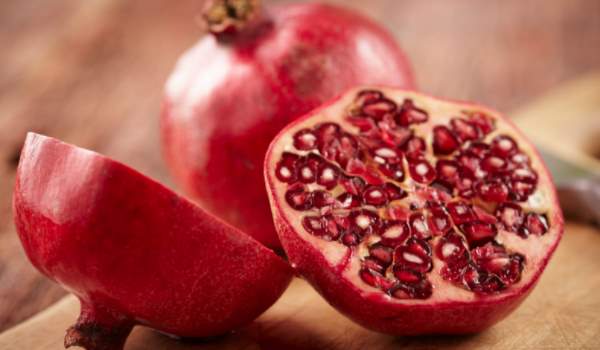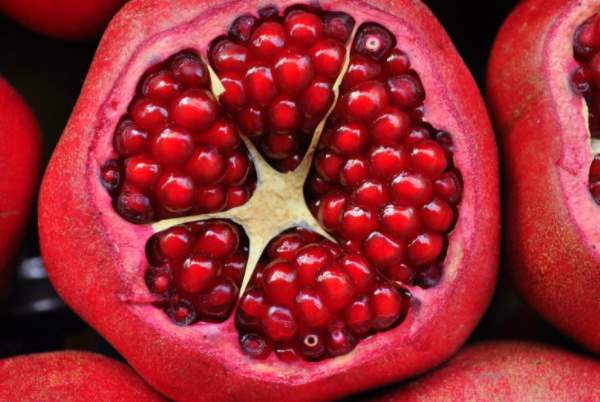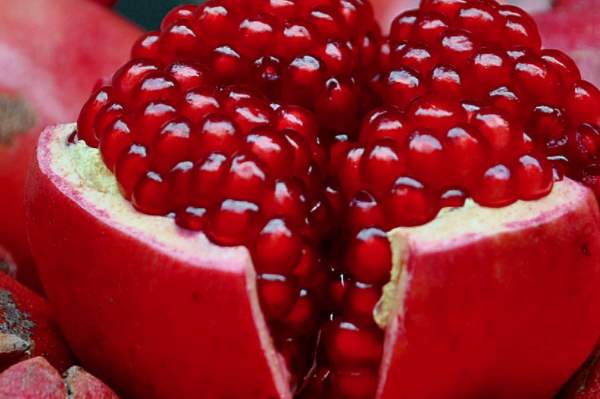Export Pomegranate To Europe .. Europe is a net importer of fresh pomegranates. In addition to the local production volume, Europe’s trade balance (imports minus exports) added an estimated 50,000 tonnes of pomegranates to the apparent consumption in 2017. Pomegranates are a luxury fruit that sells well in the higher segment. The demand for more exotic and healthy fruit can help increase profitability for exporters from developing countries.
Export Pomegranate Product definition

The pomegranate (Punica granatum) is a tree about 5– 8 metres in height that bears fruits with a diameter of around 10 cm. The skin of the fruit is reddish and thick. The edible part consists of the hundreds to thousands of small seeds or arils inside the fruit.
Pomegranates are cultivated in large parts of the world, including Latin America, southern Europe, Asia and Africa. They can be grown in tropical to warm temperate climates, although the best-quality fruits are produced in regions with cool winters and hot, dry summers. In the northern hemisphere, pomegranates are typically in season from September to February, while in the southern hemisphere, they are in season from March to May.
Read
Export Pomegranate The pomegranate
has more than 500 named cultivars, several of which are available on the European market. Cultivars that are produced in Europe (mainly Spain) include ‘Mollar de Elche’, ‘Mollar Valenciana’, and ‘Wonderful’. However, new varieties have been introduced in recent years.
Which European markets offer opportunities for exporters of fresh pomegranates?
NOTE: The trade statistics below are indicative, as there are no specific data for pomegranates. The analysis is based on the product code HS 08109075 (see product description above). This product group includes pomegranates and other fruit including cherimoya, barbary figs and medlars. According to sector experts, pomegranates are the most important product in this group.
Growing import from developing countries
The product group in which pomegranates are included shows a year-on-year import increase. The total import volume developed from 67,000 tonnes in 2013 to 95,000 tonnes in 2017. Responsible for this growth are suppliers from developing countries, with Turkey and Peru as the main drivers. The import from other non-European countries is stable and mainly originates from Israel and Chile.
Also Read
Export Pomegranate Germany is a main destination for pomegranates
Climate conditions in northern European countries are not suitable for the production of pomegranates. These countries rely on imports of pomegranates from southern Europe, as well as from producing countries outside Europe.
A large part of the imported pomegranates end up in Germany. Most of its volumes come from Turkey and Spain, which are supplemented by other countries supplied through the Netherlands Because Germany has almost no (re-) export of pomegranates, they are the principle destination. The growing second destination market is Italy, followed by France and the United Kingdom.
Most of the import of pomegranates goes through the Netherlands.
Europe is a net importer of pomegranates, with an estimated net volume (import minus export) of close to 50,000 tonnes in 2017. Most of the import from developing countries, such as Colombia, Peru and South Africa, goes through the Netherlands. From here, pomegranates are distributed all over Europe, with Germany as the most important buyer.
Other countries that import relatively large volumes from origin countries are Austria (mainly from Turkey) and the United Kingdom (mainly from Turkey and Peru). According to trade statistics, Austria re-exports a fair amount of the imported pomegranates to Germany.
Read
Spain competes from October to January
During the local pomegranate season from October until January, Spain will actually become a strong competitor. As a supplier, you will find few opportunities because the Spanish import is still very limited.
Spain has the largest production of pomegranates in Europe, reaching 50,000 tonnes, most of which are Mollar de Elche, an exceptionally sweet variety with a cream-red outside colour and a ‘protected denomination of origin’ (PDO). As a result, Spain does not only have a high consumption of pomegranates, but it is also the number one supplier within Europe.
The production in Greece and Italy is also increasing. Contrary to Spain and Greece, in Italy demand exceeds supply and you can find foreign competition from Spain, Turkey and Israel.
Which trends offer opportunities in the European market for pomegranates?
Export Pomegranate Health as an important driver of growth

In the European media, pomegranates have been classified as a ‘super fruit’. This means that they are valued for their exceptional characteristics that people relate to a healthy diet, such as their high levels of punicic acid (seed oil), vitamin c and antioxidants.
Given the tendency of European consumers to embrace fruits that are healthy and tasty, health benefits are one of the main drivers of the commercial success of pomegranates.
Export Pomegranate Pomegranates are popular as an ingredient
The marketing value of pomegranates as a super fruit has not remained unnoticed by the food industry and food services. In the past years, pomegranates have become a popular ingredient for fruit juices, flavoured water, jams, and in salads and desserts. You can also find pomegranate seed oil as a food supplement and in personal care products.
Product development and recipes help significantly in the promotion of fresh pomegranates. As consumers become more familiar with the fruit and its potential uses, they are increasingly using it in food and drink preparation at home. One of the strong pomegranate marketing companies is Pom Wonderful, which is also active with a number of products in Europe.
Export Pomegranate Preference for convenience fruit
European consumers are increasingly expressing a preference for fruit that is easy to prepare and ready to eat. Therefore, pomegranates are not only sold as a whole fruit, but supermarkets are also offering the arils or fruity seeds packaged as a fresh or deep-frozen product.
Export Pomegranate Growing interest in sustainable fruit
In Europe, trends in the consumption of fresh fruit are developing towards more sustainable approaches to production and processing. Environmental and social issues are becoming increasingly important. Social and environmental certification schemes include actions aimed at sharply reducing and registering the use of pesticides, taking action to ensure the safety of employees and/or even including price guarantees for producers.
Export Pomegranate Organic demand becomes stronger

The increased attention to health and the environment is also generating more interest in organically produced fruits and vegetables. The demand for organic is strongest in northern Europe, but the market for pomegranates is not developed to the same extent as in the south, where pomegranates are a local product.
You have to consider organic pomegranates as a niche, but given their healthy and exclusive reputation, an organic label is an interesting feature.
Export Pomegranate Flavour and appearance are important
Flavour is becoming increasingly important to European consumers, as is the appearance of the fruit. An attractive, deep-red pomegranate skin colour is appealing to retail consumers.
Southern European countries, such as Spain, have always had a focus on taste and sweetness. Because pomegranates are among the more exclusive fruits, consumers from other regions also put more emphasis on flavour. In northern Europe, the preferred taste tends to go more towards the semi-sour varieties.







